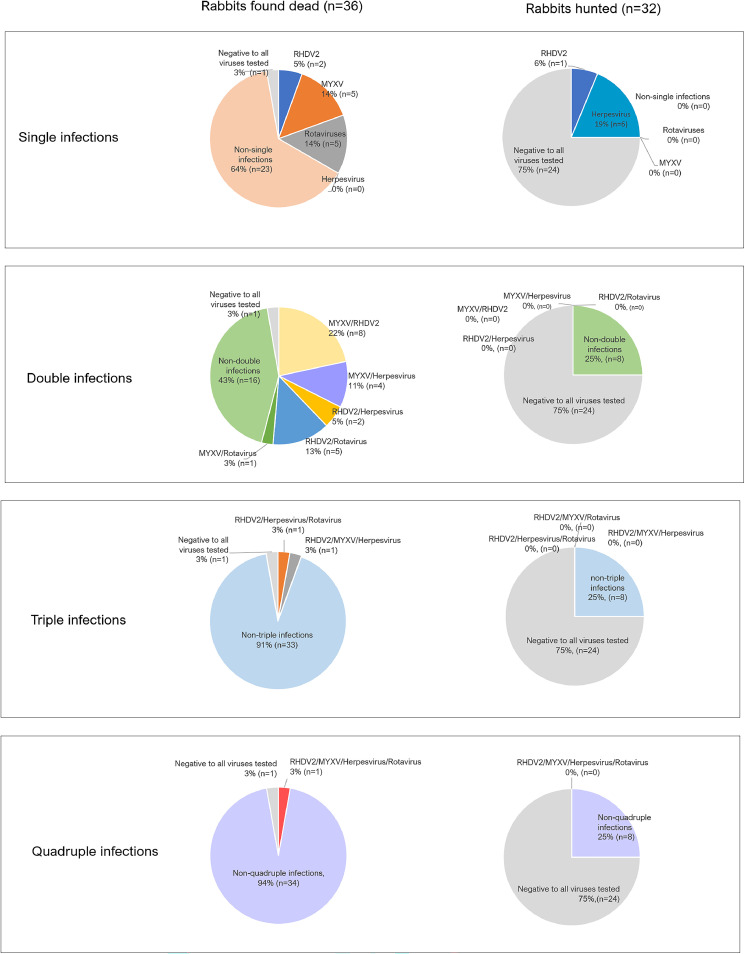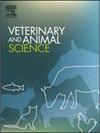Mixed viral infections (Rotavirus, Herpesvirus and others) in European wild rabbits
IF 1.9
Q2 AGRICULTURE, DAIRY & ANIMAL SCIENCE
引用次数: 0
Abstract
Infectious viral pathogens significantly impact wild Leporidae populations, particularly Oryctolagus cuniculus algirus, which was listed as 'Endangered' in 2019. Myxomatosis and rabbit haemorrhagic disease are major contributors to severe epizootics with limited long-lasting immunity. This study expanded beyond these well-documented viruses to include a broader spectrum of viruses in 36 wild rabbit carcasses (O. c. algirus) collected from the field in 2018, 2019, 2021 and 2024, and 32 wild rabbits hunted in 2017/2018. Using molecular techniques, we detected myxoma virus (MYXV) (58.3%), rabbit haemorrhagic disease virus 2 (RHDV2/GI.2) (52.8%), herpesviruses (22.2%) and rotaviruses (48.1%) in the rabbits found dead. Co-infection with MYXV and RHDV2 was found in 27.8% of cases, much higher than previously reported. All hunted rabbits tested negative for MYXV and rotavirus, one was positive for RHDV2 (3.13%) and six for herpesvirus (18.75%). No coronaviruses, adenoviruses or paramyxoviruses were detected. Herpesviruses in apparently healthy hunted rabbits suggests a low clinical impact but the potential for severe outcomes in the presence of other pathogens. This study represents the most comprehensive virological survey of O. c. algirus in Iberia and is the first to document triple and quadruple viral co-infections in rabbits.

欧洲野兔的混合病毒感染(轮状病毒、疱疹病毒和其他病毒)。
传染性病毒病原体严重影响了野生狐蛉种群,尤其是2019年被列为“濒危”物种的小叶卷毛猴。黏液瘤病和兔出血性疾病是造成严重动物流行病的主要原因,长期免疫力有限。这项研究扩展了这些有充分记录的病毒,包括2018年、2019年、2021年和2024年从野外收集的36具野兔尸体(o.c. algirus)和2017/2018年捕获的32只野兔的更广泛的病毒。应用分子技术在死亡家兔中检出黏液瘤病毒(MYXV)(58.3%)、兔出血性疾病病毒2 (RHDV2/GI.2)(52.8%)、疱疹病毒(22.2%)和轮状病毒(48.1%)。同时感染MYXV和RHDV2的病例占27.8%,远高于先前报道。所有猎兔的MYXV和轮状病毒检测均为阴性,RHDV2阳性1例(3.13%),疱疹病毒阳性6例(18.75%)。未检出冠状病毒、腺病毒、副粘病毒。疱疹病毒在明显健康的猎兔中表明临床影响较低,但在其他病原体存在时可能导致严重后果。这项研究代表了伊比利亚地区最全面的褐藻O. c. algirus病毒学调查,并且是第一个记录家兔三次和四次病毒合并感染的研究。
本文章由计算机程序翻译,如有差异,请以英文原文为准。
求助全文
约1分钟内获得全文
求助全文
来源期刊

Veterinary and Animal Science
Veterinary-Veterinary (all)
CiteScore
3.50
自引率
0.00%
发文量
43
审稿时长
47 days
 求助内容:
求助内容: 应助结果提醒方式:
应助结果提醒方式:


